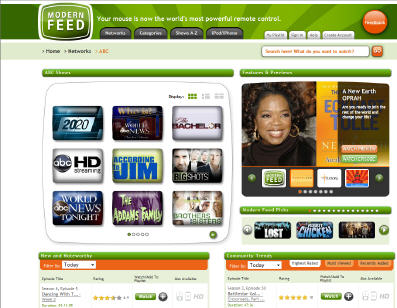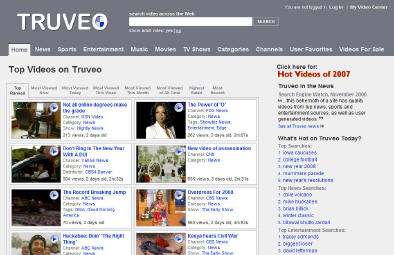-
Truveo Helps Clear Video Search Fog with New Study
A couple of days ago, Truveo, the big video search engine owned by AOL, released the results of an internal study which concluded that it provides the most comprehensive search results among 5 companies considered. Before you say, "Duh, Will, what else would you have expected Truveo to conclude?!" it's worth spending a few minutes considering the study's methodology, results and implications. Video search is an extremely strategic space, so all credible data has value.
When it comes to search, there are really two key criteria to judge quality - coverage and relevancy. A search engine can return a million results, but if none are relevant, it's pointless. Conversely, just one spot-on result and you'll rejoice, but you still may yearn for additional, relevant options (since video quality can vary, links may be broken, the user experience at certain sites may stink, etc.). So optimizing both coverage and relevancy must be the goal.
In Truveo's study, it has focused solely on coverage, having deemed relevancy too subjective to credibly
 measure. To quantify coverage from a competitive standpoint, it chose 4 other search engines, Blinkx, Microsoft Live Video Search, Google Video and Yahoo Video. This limited pool immediately begs the question how the many other video search companies not included would have fared. Truveo explained that the testing was very resource-intensive, so they needed to keep the competitive set relatively small.
measure. To quantify coverage from a competitive standpoint, it chose 4 other search engines, Blinkx, Microsoft Live Video Search, Google Video and Yahoo Video. This limited pool immediately begs the question how the many other video search companies not included would have fared. Truveo explained that the testing was very resource-intensive, so they needed to keep the competitive set relatively small.To measure coverage, Truveo selected 100 top-ranked Alexa sites across 5 categories: news, sports, TV, music and movies. Then they found 10 representative videos from each and ran a query for those videos - using the exact title the site used - on each of the 5 search engines. Scoring was binary - a search engine got a 1 if they returned an accurate result for at least 5 of the 10 queries, a zero if they didn't. Final score from this process, Truveo 86, Blinkx 20, Microsoft Live Video Search 17, Google Video 3, and Yahoo 2.
Having reviewed the test's full methodology and spoken to a Truveo representative, I think for the most part their approach is pretty fair. An obvious limitation is that lots of video search engines (or web search engines like Google) weren't evaluated so the study is by no means conclusive. Further, only premium sites were included (i.e. no UGC, and actually very little indie video either), so one wonders how the results would have changed if sites like Break.com, Heavy and others were also tested. And then there's the small matter of YouTube, the market's 800 pound gorilla, not being included at all. Since for many users video search begins and ends with YouTube, its omission raises a question about just how reflective these results are of real-world user behavior.
Nonetheless, Truveo gets points in my book for shedding further light on a very confusing subject, and also constructing a relatively objective methodology that can be used by others (in fact Truveo is encouraging independent 3rd parties to undertake more testing of this kind).
Video search is one of the most intellectually challenging areas of the broadband video ecosystem, yet as Truveo asserts, there is surprisingly little evaluative data out there. From my standpoint, more data means more informed market participants and therefore continually improving user experiences. That benefits everyone in the broadband ecosystem.
What do you think? Post a comment now.
(Note, the complete methodology can be requested by emailing Josh Weinberg at jweinbergATtruveo.com)
Categories: Video Search
Topics: Blinkx, Google Video, Microsoft Live Video Search, Truveo, Yahoo Video, YouTube
-
Pixsy Zeroes in on White-Label Video and Image Search
As the proliferation of broadband video continues apace, the task of finding what you're looking for is only intensifying. That's set off a scramble by many to solve this problem, trying to become in effect, the "Google of video search."
I've previously written about players such as blinkx, Truveo, ClipBlast, Veveo and EveryZing. The latest video search company to hit my radar is Pixsy, which has its own distinctive approach for capturing its share of the growing video search market. I recently spoke with Chase Norlin, Pixsy's CEO to learn more.
Pixsy has three key differentiators:
First, it's purely focused on the B2B white-label opportunity, eschewing the destination site route. Pixsy only wants to power other sites' search capabilities as a white-label provider.
Second, in addition to video search, Pixsy also does image search, which Chase believes is actually the fastest growing part of the search market. Being able to offer image search broadens Pixsy's value proposition to partners, driving enhanced monetization opportunities.
Third, Pixsy doesn't seek to have the broadest index, rather it seeks to balance the breadth of its index with having the most current results. It uses RSS feeds, not web crawlers, to build its index and focuses mainly on current events categories like news, sports and entertainment. Clearly having the most up-to-date results in these kinds of categories is a real plus.
Pixsy's approach seems to be paying off, as it is now powering video and/or image search at sites including
 Veoh, Lycos, PureVideo, National Lampoon and others. This morning it's also announcing a deal with MMORPRG.com, the web's largest massive multiplayer online role playing site.
Veoh, Lycos, PureVideo, National Lampoon and others. This morning it's also announcing a deal with MMORPRG.com, the web's largest massive multiplayer online role playing site. Pixsy works with a number of business models. Sites generating anything under 10K search queries per month can freely use Pixsy's API. Above that volume, Pixsy licenses its index with about a third of partners selling their own ads, and the other two-thirds relying on Pixsy to sell the ads alongside the search results. As Google and others have shown, search results are extremely monetizable.
Based in Seattle and San Francisco, much of Pixsy's team comes from Microsoft and ValueClick. Considering it has been around for about 2 years, has only 15 employees and has raised just an angel round, Pixsy seems to show that the barriers to entry for savvy video search startups can be relatively low. With so many other video search players, I anticipate the category is going to remain fragmented and chaotic for some time to come.
Categories: Video Search
Topics: Blinkx, ClipBlast, EveryZing, Pixsy, Truveo, Veveo
-
Modern Feed Jumps Into Video Navigation Space
With the proliferation of available broadband video comes a massive user navigation challenge. Modern Feed is launching today to address this. It is part search engine, part aggregator, with a specific focus on indexing professionally-produced programming, not user-generated video. It's also focused on actual programs, not promotional clips.
J.D. Heilprin, Modern Feed's founder/CEO told me yesterday that the company is targeting mainstream users providing the easiest way to find available, high-quality video. It employs a team of "Feeders" charged with curating the best videos to include on the site. The result is approximately 550 "networks" and 25,000 pieces of content now indexed, where "networks" is a loose term ranging from traditional broadcasters to indies new entrants like Boston Symphony or Architectural Digest.
Modern Feed is rights-holder friendly, not indexing any illegal or pirated video, and playing the video from the source's site (though sometimes with a thin Modern Feed navigation frame at the top of the screen). I played around with Modern Feed and found it to be easy-to-use and well-laid out. Modern Feed also offers an iPhone implementation that looks pretty cool, other devices are to follow.
The big challenge (and opportunity) for Modern Feed is that it's entering a very noisy space where user behavior is very undefined. There are myriad video search engines (Truveo, ClipBlast, blinkx, Veveo), portals (AOL, Yahoo, MSN), navigation sites (TV Guide, recently-launched PrimeTime Rewind) and of course the networks' own sites (and syndication efforts) offering users the ability to quickly find quality content. Then there's YouTube, the first stop for many users when it comes to video. And YouTube is increasingly moving up market by striking partnerships with premium providers.
Modern Feed's strong user experience, focus on mainstream users and device integrations are differentiators for the company. Whether these are ultimately success factors really depends on how user behavior unfolds in the nascent video navigation space. Modern Feed has raised several million dollars from angels and has 30 full-timers with aggressive growth planned.
What do you think? Post a comment and let everyone know!
See prior posts:
YouTube, C-SPAN Team Up for User-Generated, Multi-Platform Voter Project
Categories: Startups, Video Search
Topics: AOL, Blinkx, ClipBlast, Modern Feed, MSN, PrimeTime Rewind, Truveo, TV Guide, Yahoo, YouTube
-
3 Broadband Video Snippets to End the Week
Closing out another busy week, here are 3 diverse broadband video snippets that hit my radar in the past few days:
1. YouTube Drives the Political Newscycle
Back in December, in 6 Predictions for 2008, I suggested that "2008 is the year of the broadband presidential election." This seems to become more evident with each passing week. I find that particularly when watching cable news, YouTube's influence just keeps on growing.
For example, I'm a fan of "AC360" on CNN, which I try to catch at 10pm each night. This week the show was constantly replaying the YouTube videos of Rev. Jeremiah Wright that have dogged the Obama campaign. Conversely, a few weeks ago, Obama got a great tailwind from the massive attention paid to the viral "Yes We Can" music video sensation by will.i.am. That of course was on top of the earlier "Obama Girl" phenomenon. Separately, the McCain campaign just yesterday fired a campaign worker for posting a controversial video on YouTube about Obama and race. This too was covered on AC360 last night. Then of course there were the YouTube co-sponsored debates, offering video-based questions that were constantly replayed afterward.
The point of all this is that broadband video has turned election coverage upside down, making it incredibly hard for candidates to control the political newscycle. The "democratizing" effect of YouTube means that on any given day, at any given moment, something may get posted which diverts the campaign's attention. And with major media outlets paying such close attention to YouTube, everything is immediately amplified. Not since the early 1960s when TV began influencing presidential politics have we seen a new medium have such a profound impact on an election. And we still have 8 months to go until November...who knows what's yet to come!
2. SI Vault is Addictive
On to something more fun, if you haven't yet checked out Sports Illustrated's new "SI Vault" site just launched this week, I suggest you do. It's a highly addictive trip down memory lane. SI has digitized all of its assets and also made available non-SI content, all in one easy-to-use location powered by Truveo. Focusing on video, I found Franco Harris's "Immaculate Reception" from the 1972 Steelers-Raiders playoff game and also Doug Flutie's famous "Hail Mary" pass to beat Miami in 1984. I could have spent hours at the site, although it's not perfect. I tried finding Tom Watson's 1982 U.S. Open chip-in at Pebble Beach to beat Jack Nicklaus, but alas no results were found. Obviously all this stuff is available elsewhere online, but SI Vault creates a great context for sports fans to enjoy themselves, wrapping SI and non-SI content together in one nice package.
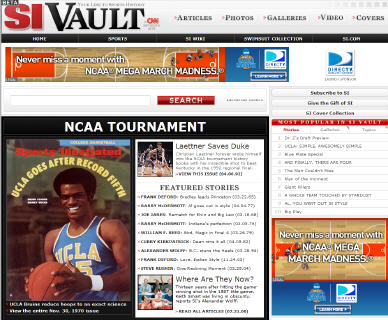
3. Apple's Roadblocks are Baaaack
And for even more fun, I encourage you to check out WSJ.com and NYTimes.com today. Apple is "roadblocking" the home pages of both again with a new Mac vs. PC ad, as they did back on Jan. 17th. This means that Apple has bought out all the home page leaderboard inventory on these 2 sites, so every time a visitor comes today, they see the same Apple ad. With all the talk about broadband video advertising, pre-rolls, overlays, etc, Apple again shows with its roadblocks how a little bit of creativity with rich media ad units can go a really long way. The ads are a great mix of interruption and opt-in and are no doubt highly effective branding units for Apple. Have a look and enjoy.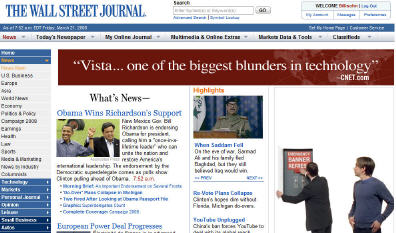
Categories: Brand Marketing, Cable Networks, Politics, Predictions, Sports, UGC, Video Sharing
Topics: Apple, Barack Obama, CNN, NYTimes.com, Sports Illustrated, Truveo, WSJ.com
-
Truveo Capitalizes on Video Search Explosion
Continuing my analysis of the video search space, just before the holidays, I had a briefing with Tim Tuttle, CEO and co-founder of Truveo, to preview some information the company released today. Started in early 2004 and acquired by AOL in December, 2005 qualifies Truveo as one of the main established players in video search.
I've been focusing a lot on this area as I believe that broadband video navigation is going to follow a similar pattern as general web content navigation -- with search taking center stage.
Truveo's growth in '07 reflects the overall surge of interest in broadband video. On the demand side, Tim reports that Truveo experienced a 20x increase in number of queries vs. a year ago. And on the supply side, Truveo has experienced a similar jump, now indexing 100 million videos, up from the 5-10 million videos it indexed at the beginning of '07.
Truveo now reaches 50 million unique visitors/mo, through its own site and across a network of partner sites where Truveo search is embedded, including AOL, MSN Video, CNET Search, Time Warner Cable, Qwest, Netvibes and many other smaller players which use Truveo's API. The company doesn't break out uniques by site, but with its recent international emphasis, Tim believes that at least 50% of its traffic now comes from outside the U.S.
A big shift Truveo has noticed in just the last 6 months is toward user searches for network TV programs and other professional video. This has displaced some of the searching for viral videos that was the traditional core. From my perspective, this is further evidence that the networks are succeeding with their online distribution initiatives. Tim sees this trend continuing in '08, as users' expectations for finding high-quality video online continues to grow.
Tim believes this shift is particularly beneficial to Truveo as it specifically built its "visual crawling" technology to find video that's in Flash or Ajax sites, and therefore hard for traditional search techniques to find.
While Truveo still operates with a fair amount of independence from its base in the Bay area, AOL seems to be recognizing more and more its strategic value. AOL has recently begun raising the visibility of Truveo in the overall AOL experience and will continue to do so.
Meanwhile on the revenue front, Tim said that the AOL acquisition has allowed Truveo to "de-prioritize" for a time its focus on revenue growth, instead concentrating on expanded reach. Despite this, Truveo is intent on capitalizing on its traffic and Tim sees the recent flurry of activity around contextual targeting as playing right to Truveo's strengths. We agreed there is much in flux about broadband video advertising and that formats beyond pre-rolls are essential. Of course what those are remains uncertain - overlays or something else?
Categories: Video Search
-
ClipBlast 3.0 Beta Released; Further Video Search Improvements
Next week ClipBlast, a player in video search space, will announce that is has launched a beta of its 3.0 product. It's actually now live and I've had a chance to play around with it for the last couple of days. I also got a briefing and demo when I met up with Gary Baker, ClipBlast's CEO, at Digital Hollywood a few weeks ago.
Video search has been a murky, yet fast-evolving area. You have to get way down into the weeds to fully understand the nuances, but here is the gist. First, video isn't nearly as searchable as text is. Video search primarily relies on metadata, which describes what's inside the video itself. This metadata can be created by the content provider or by the video search engine itself using techniques like speech-to-text processing. A key challenge for video search engines has been returning results in which the context matches what the user was intending. This is no easy feat, as the same word can obviously be used in many different contexts, yielding lots of useless results.
ClipBlast's 3.0 beta is crawling 10,000 different video providers now and they've continued to make many enhancements to their metadata processing. They've also done a lot of work to improve user navigation so that browsing is a viable complement to search. (This gets to how users actually interact with video search engines, which is yet another issue in the video search world). ClipBlast now places all videos into 70 different categories, which have easy scrolling thumbnails, showcases featured clips and featured partners and today's most popular searches.
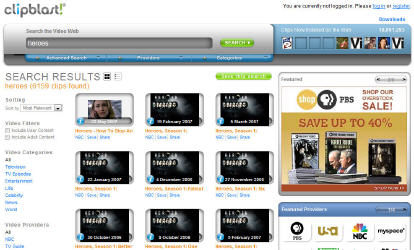
ClipBlast has also introduced more personalization features such as saving providers, categories, searches and results. You can also configure your own personal home page and set email alerts for when new video matching your search criteria. Perhaps most fun is a new widget feature, allowing ClipBlast widgets to be embedded on your desktop and blog with customized video. Gary demo'd this for me and it's quite cool. It's only available for Macs right now with a PC release coming soon.
I'm planning a deeper dive into video search in December and will have more detailed analysis on the category then. In the mean time I suggest the best way to get into it and evaluate which video search engine is best for you is to run the same search across some of the more popular video search engines. A good list would include: Truveo (now owned by AOL), Google (still officially in "beta"), blinkx, SearchForVideo, EveryZing, Dabble, Pixsy, Fooooo and others I'm sure I'm missing.
I'm interested in what you find, so please post a comment or email me.
Categories: Video Search
Topics: AOL, Blinkx, Dabble, EveryZing, Fooooo, Google, Pixsy, SearchForVideo, Truveo
Posts for 'Truveo'
|

